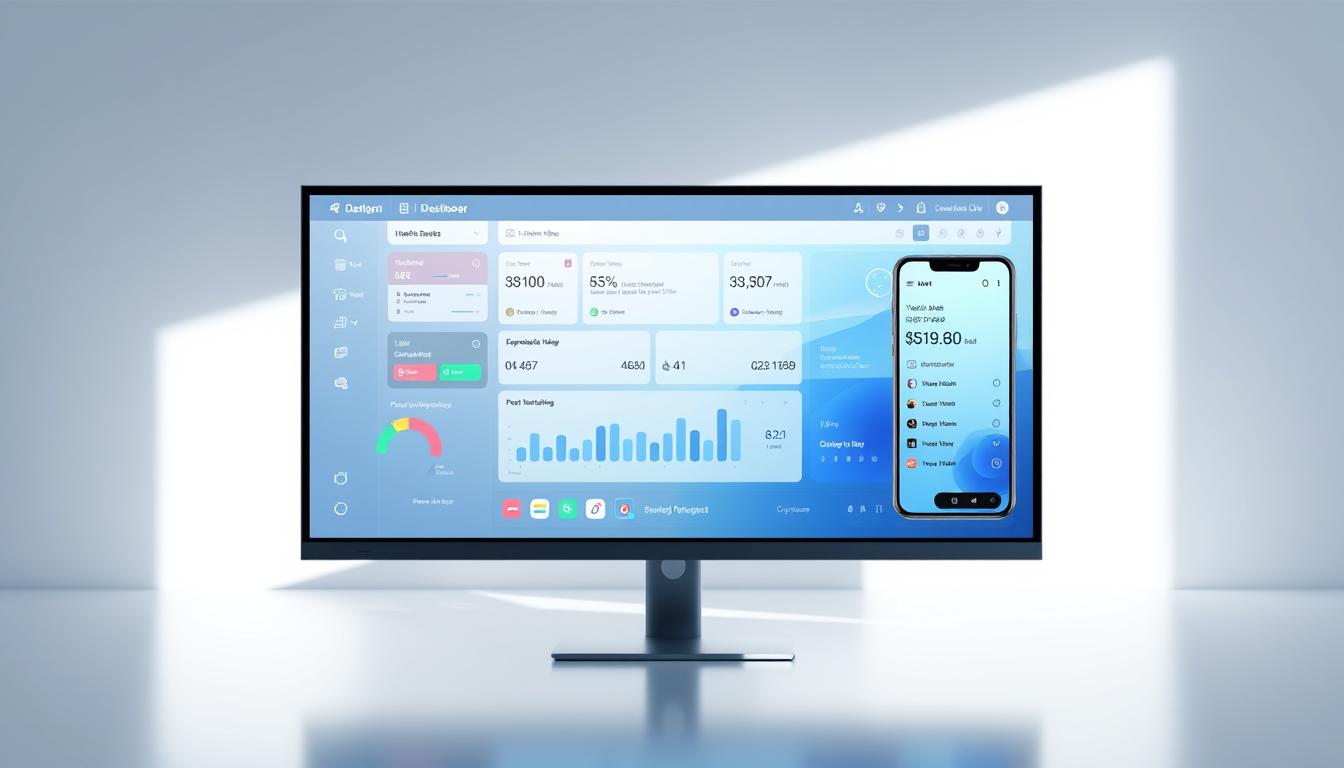In today’s digital landscape, creating visually appealing and user-friendly interfaces is crucial for success. As technology continues to evolve, the demand for professionals with expertise in user interface design and user experience design is on the rise.
This comprehensive guide will walk you through the process of developing essential UI/UX design skills, covering the fundamental principles and best practices to help you create interfaces that are both aesthetically pleasing and intuitive to use.
Key Takeaways
- Understanding the importance of UI/UX design skills
- Learning the fundamental principles of user interface design
- Discovering best practices for creating user-friendly interfaces
- Developing skills to create visually appealing designs
- Applying user experience design principles to real-world projects
Understanding UI/UX Design Fundamentals
Effective UI/UX design is not just about creating visually appealing interfaces; it’s about understanding the user’s needs and behaviors. This understanding forms the foundation of UI/UX design, enabling designers to craft products that are both functional and enjoyable to use.
Differentiating Between UI and UX Design
UI (User Interface) design focuses on the visual aspects of a product, such as the layout, colors, and typography. On the other hand, UX (User Experience) design encompasses the overall experience a user has when interacting with a product, including how easy or difficult it is to use. While UI is about the product’s look and feel, UX is about its usability and the emotions it evokes.
The Role of User-Centered Design Thinking
Design thinking is a problem-solving approach that puts the user at the forefront. It involves empathizing with users, defining their needs, ideating solutions, prototyping, and testing. This user-centered approach ensures that the design solutions are relevant, useful, and desirable.
How Strong UI/UX Drives Business Results
A well-designed UI/UX can significantly impact business success. It can enhance user engagement, reduce bounce rates, and increase conversion rates. For instance, a simple and intuitive interface can make a product more appealing, leading to higher customer satisfaction and loyalty.
| Business Metric | Impact of Good UI/UX |
|---|---|
| User Engagement | Increased time spent on the platform |
| Conversion Rates | Higher percentage of users completing desired actions |
| Customer Satisfaction | Improved user experience leading to positive reviews and loyalty |

Essential UI/UX Design Skills to Develop
To excel in UI/UX design, it’s crucial to develop a robust set of skills that cater to the ever-evolving digital landscape. As UI/UX designers, the ability to adapt and grow with the industry is paramount.
Cultivating Design Thinking and Problem-Solving
Design thinking is at the core of UI/UX design, enabling designers to empathize with users, define problems, and ideate innovative solutions. Effective problem-solving involves a deep understanding of user needs and the ability to iterate based on feedback. By fostering a culture of experimentation and continuous learning, designers can refine their skills in design thinking.
Mastering Visual Design Principles
Visual design principles play a crucial role in creating aesthetically pleasing and user-friendly interfaces. Understanding typography, color theory, and layout is essential for crafting visually appealing designs that guide the user’s attention and facilitate interaction.
Conducting Effective User Research
User research is a critical component of UI/UX design, providing valuable insights into user behavior, preferences, and pain points. By employing various research methods, such as user interviews and usability testing, designers can gather data-driven insights to inform their design decisions.
Developing Cross-Functional Communication Skills
Effective communication is vital in UI/UX design, as it involves collaboration with cross-functional teams, including developers, product managers, and stakeholders. Clear and concise communication ensures that design solutions meet business objectives and user needs, facilitating a smoother design-to-development handover.
By focusing on these essential skills, UI/UX designers can enhance their capabilities, drive business results, and create user-centered design solutions that resonate with their target audience.
Learning UI/UX Design Tools and Software
To become a proficient UI/UX designer, one must be familiar with a range of tools and software that facilitate the design process. Effective UI/UX design is not just about understanding design principles, but also about leveraging the right tools to bring those principles to life.
The UI/UX design process involves several stages, from wireframing and prototyping to visual design and testing. Each stage requires specific tools and software to ensure that the design is both aesthetically pleasing and user-friendly.
How to Create Wireframes and Interactive Prototypes
Creating wireframes and interactive prototypes is a crucial step in the UI/UX design process. Wireframing allows designers to visualize the basic structure of a website or application, while prototyping enables them to test and refine the design’s functionality and usability.
Tools like Figma, Sketch, and Adobe XD are popular choices for wireframing and prototyping. These tools offer a range of features, including drag-and-drop interfaces, collaboration tools, and the ability to create interactive prototypes.
Essential Graphic Design Software for UI Designers
While wireframing and prototyping are critical steps in UI/UX design, visual design is equally important. Graphic design software like Adobe Photoshop and Illustrator are essential tools for UI designers, enabling them to create high-quality visual elements, such as icons, graphics, and typography.
These tools offer advanced features, including layer management, effects, and color management, which are crucial for creating visually appealing designs.
Understanding Basic Coding for Better Designer-Developer Collaboration
Having a basic understanding of coding principles can significantly enhance collaboration between designers and developers. By understanding how their designs will be implemented, designers can create more feasible and effective designs.
Basic knowledge of HTML, CSS, and JavaScript can help designers communicate more effectively with developers and make informed design decisions.
Step-by-Step Process to Build Your UI/UX Portfolio
Creating a strong UI/UX portfolio requires a strategic approach. It involves several steps that help designers showcase their skills and experience to potential employers.
Study Design Theory Through Courses and Resources
The first step in building a UI/UX portfolio is to study design theory. This involves taking courses and utilizing resources that teach user interface design and user experience design principles. Designers can leverage online platforms like Coursera, Udemy, and Skillshare to learn from industry experts.
Some key topics to focus on include design thinking, human-computer interaction, and visual design principles. By mastering these concepts, designers can develop a solid foundation for their portfolio.
Practice With Self-Initiated Projects
The next step is to practice with self-initiated projects. This involves applying the knowledge gained from design theory to real-world problems. Designers can create hypothetical projects or redesign existing products to demonstrate their skills.
A list of potential project ideas includes:
- Redesigning a mobile app or website
- Creating a new product or feature
- Improving the user experience of an existing product
Implement Feedback and Iteration Cycles
After completing self-initiated projects, it’s essential to implement feedback and iteration cycles. This involves seeking feedback from peers, mentors, or potential employers and using it to improve the design.
Designers can participate in design communities, attend critique sessions, or join online forums to receive constructive feedback on their work.
Showcase Your Work Through a Professional Portfolio
The final step is to showcase your work through a professional portfolio. This involves curating the best projects and presenting them in a clear and concise manner.
A well-structured portfolio should include:
- A brief introduction to the project
- Design process and problem-solving approach
- Final design solution and results
By following these steps, designers can create a compelling UI/UX portfolio that showcases their skills and experience, making them more attractive to potential employers.
Applying UI/UX Skills in Real-World Projects
To succeed in real-world projects, UI/UX designers must leverage their skills in creating intuitive and user-friendly interfaces. This involves a combination of several key elements, including a well-structured information architecture, responsive design, and thorough usability testing.
How to Create Effective Information Architecture
Effective information architecture is crucial for any UI/UX project. It involves organizing content in a logical and user-friendly manner, making it easier for users to navigate and find what they need. As “Information architecture is not just about the structure, it’s about making the structure intuitive”, says a renowned UX expert. A well-designed information architecture should be intuitive, allowing users to accomplish their goals with minimal effort.
Implementing Responsive Design Across Devices
With the vast array of devices available, from smartphones to desktop computers, implementing responsive design is no longer optional. It ensures that the UI/UX design adapts seamlessly to different screen sizes and devices, providing an optimal user experience across the board. Responsive design involves using flexible grids, images, and media queries to create a consistent and engaging interface.
Conducting Usability Testing and Analyzing Results
Usability testing is a critical component of the UI/UX design process. It involves testing the product with real users to identify any usability issues and areas for improvement. By analyzing the results of usability testing, designers can make informed decisions to enhance the user experience, ultimately leading to higher user satisfaction and engagement.
By focusing on these key areas, UI/UX designers can effectively apply their skills in real-world projects, driving both user satisfaction and business success.
Conclusion
Developing essential UI/UX design skills is crucial for creating engaging and user-friendly digital products. As highlighted throughout this article, a strong foundation in user interface design and user experience design is vital for success in web design.
By cultivating design thinking, mastering visual design principles, and conducting effective user research, designers can create intuitive and aesthetically pleasing interfaces. Applying these UI/UX design skills in real-world projects enables designers to drive business results and deliver high-quality user experiences.
As the web design landscape continues to evolve, it’s essential to stay up-to-date with the latest UI/UX trends and best practices. By doing so, designers can create innovative and effective solutions that meet the needs of users and businesses alike, ultimately enhancing the overall user experience in web design.
FAQ
What are the key skills required for a UI/UX designer?
UI/UX designers require a range of skills, including design thinking, visual design principles, user research, wireframing, prototyping, and cross-functional communication. They should also be proficient in design tools like Sketch, Figma, Adobe XD, and InVision.
How does UI/UX design impact business results?
Effective UI/UX design can drive business results by improving user engagement, increasing conversion rates, and enhancing customer satisfaction. A well-designed interface can also help to establish a brand’s identity and build trust with its users.
What is the difference between UI and UX design?
UI (User Interface) design focuses on the visual aspects of a product, such as typography, color schemes, and layout. UX (User Experience) design, on the other hand, encompasses the entire user experience, including user research, wireframing, and usability testing.
How can I develop my UI/UX design skills?
To develop your UI/UX design skills, you can take online courses, attend workshops, and participate in design communities. You can also practice by working on personal projects, conducting user research, and testing your designs with real users.
What is the importance of user research in UI/UX design?
User research is crucial in UI/UX design as it helps designers understand their target audience, identify user needs, and develop solutions that meet those needs. It involves gathering data through various methods, such as interviews, surveys, and usability testing.
How can I create a professional UI/UX portfolio?
To create a professional UI/UX portfolio, you should showcase your best work, including case studies that demonstrate your design process and problem-solving skills. You should also highlight your skills and experience, and make sure your portfolio is visually appealing and easy to navigate.
What is the role of wireframing and prototyping in UI/UX design?
Wireframing and prototyping are essential tools in UI/UX design, allowing designers to visualize and test their ideas before investing time and resources into development. Wireframes provide a basic layout of a product, while prototypes offer a more interactive and detailed representation.
How does responsive design impact UI/UX?
Responsive design is critical in UI/UX as it ensures that a product’s layout and functionality adapt to different screen sizes and devices. This provides a consistent and optimal user experience across various platforms, from desktop to mobile.
